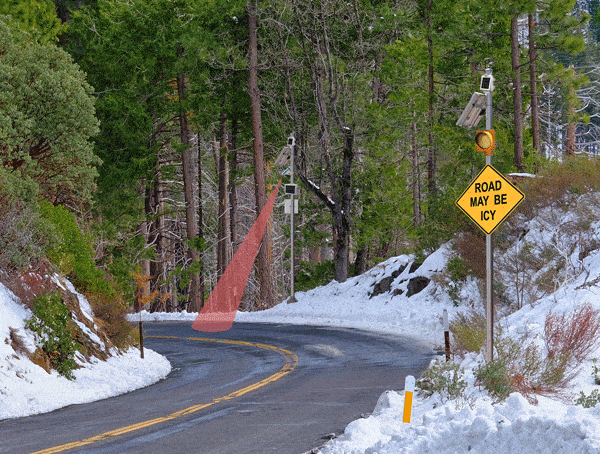Weather conditions can shift rapidly and unpredictably, creating hazardous situations that challenge even the most seasoned drivers. Floods, ice, and fog not only endanger lives but also disrupt urban mobility, create gridlock, and place enormous strain on emergency responders and city infrastructure. Traditional traffic management systems, often static and reactive, struggle to adapt quickly enough, leaving cities vulnerable to weather-related chaos.
Kemetra solves this pressing challenge by integrating real-time weather-responsive capabilities into its advanced traffic management systems. Our AI-driven platform dynamically adapts signal timing, deploys immediate alerts, and coordinates cross-agency responses—keeping roads safe, cities moving, and communities protected through even the most extreme weather conditions.
The Hidden Risks of Severe Weather
Severe weather incidents—including flash floods, icy roadways, dense fog, and heavy rain—pose significant risks to urban safety and mobility. Flooded streets can rapidly become impassable, icy intersections trigger accidents within seconds, and fog severely restricts visibility, turning everyday commutes into dangerous situations.
Traditional traffic systems usually rely on manual interventions or pre-set static plans that rarely reflect rapidly changing conditions. As a result, cities often react too late, causing unnecessary congestion, dangerous collisions, delayed emergency response, and widespread public frustration. Kemetra transforms this outdated model, introducing dynamic, real-time responsiveness that ensures traffic management evolves alongside the weather itself.
Live Integration of Weather Data
At the heart of Kemetra’s weather-responsive system is real-time integration with live weather data feeds, advanced road surface sensors, and environmental detection technologies. Our platform continuously analyzes data from sensors placed strategically throughout the city, measuring rainfall intensity, road temperature, fog density, and surface conditions to identify emerging risks instantly.
For example, sensors embedded in roadways detect freezing temperatures or ice formation long before accidents occur. Similarly, advanced flood detection sensors provide early warnings of rising water levels at critical intersections. By combining this real-time data with predictive analytics, our platform proactively manages traffic conditions before hazardous situations escalate.
Dynamic Signal Timing for Immediate Safety
When severe weather strikes, timing is everything. Kemetra’s AI-driven traffic signals automatically adjust their timing plans based on real-time weather conditions, instantly reducing speeds, extending red lights, and managing traffic flow safely. This rapid adjustment capability prevents dangerous collisions caused by slick roads, reduces traffic volume in flood-prone areas, and ensures drivers have ample time to respond to visibility issues in foggy conditions.
During icy conditions, our platform lengthens signal cycles to slow vehicle speeds, preventing sudden stops or skids. In foggy conditions, coordinated “slow-wave” patterns help drivers maintain safer distances and navigate intersections more cautiously. When floods threaten roadways, signals reroute traffic to higher ground automatically, minimizing risks and congestion.
Real-Time Driver and Community Alerts
Immediate awareness is essential for public safety during severe weather. Kemetra’s integrated communication system instantly disseminates targeted alerts and warnings directly to connected vehicles, roadside displays, mobile apps, and municipal emergency systems. Alerts include real-time updates about hazardous conditions, recommended speeds, alternative routes, and necessary precautions, ensuring drivers remain informed, safe, and prepared.
For instance, upon detection of flooding in low-lying areas, drivers approaching the area instantly receive automatic in-vehicle notifications directing them toward safer routes. Similarly, when visibility suddenly drops due to dense fog, our platform immediately alerts nearby drivers to slow down, improving safety for everyone involved.
Cross-Agency Automation and Coordination
Effective response to severe weather events demands seamless coordination among city agencies, first responders, public works departments, and emergency management authorities. Kemetra’s system automates cross-agency alerts and communications, ensuring critical information reaches decision-makers immediately.
When our sensors detect hazardous weather conditions, automated alerts notify emergency responders, maintenance crews, and traffic management centers simultaneously, enabling coordinated and effective responses. For example, detection of icy conditions automatically triggers dispatch of salt and sand crews, while fog alerts immediately mobilize police units to slow traffic in affected areas.
Digital Twin Simulations for Strategic Weather Preparedness
Kemetra’s digital twin simulations offer cities powerful predictive tools to proactively prepare for severe weather events. These virtual replicas of real-world road networks allow city planners and emergency responders to model various scenarios—such as extreme flooding, ice storms, or dense fog—and test the effectiveness of potential responses.
Digital twin simulations help cities refine and optimize weather-responsive traffic plans, evacuation routes, and emergency deployment strategies long before real-world conditions unfold. As a result, city agencies are better equipped and more confident in managing unpredictable weather events effectively.
Continuous Improvement Through Data-Driven Insights
Every severe weather incident offers critical insights for future improvements. Kemetra’s platform automatically compiles comprehensive reports on how effectively traffic management systems responded to weather conditions, highlighting successes and identifying potential enhancements. Metrics such as response times, congestion mitigation effectiveness, and accident reductions are continually tracked, enabling cities to progressively refine their weather management strategies.
Our actionable analytics empower city leaders and emergency managers to learn from every incident, implement targeted safety improvements, and deliver increasingly robust responses to weather challenges over time.
Supporting Vision Zero and Urban Resilience Goals
Ultimately, Kemetra’s weather-responsive traffic management aligns directly with broader urban goals like Vision Zero and citywide resilience. By proactively managing hazardous conditions, our solutions significantly reduce accidents, improve road safety, and ensure reliable urban mobility even under challenging weather scenarios.
Cities equipped with Kemetra technology confidently manage severe weather threats, knowing they have the tools to rapidly adapt, respond, and protect citizens effectively. Our approach demonstrates that modern, intelligent traffic management isn’t merely about convenience—it’s about ensuring public safety, resilience, and peace of mind for entire communities.
Through real-time weather-responsive traffic management, Kemetra is setting new standards in urban safety, preparedness, and resilience. By leveraging real-time data integration, dynamic signal adjustments, and proactive cross-agency coordination, our solutions empower cities to face floods, ice, fog, and other weather hazards confidently—transforming everyday traffic management into a powerful tool for community protection.


